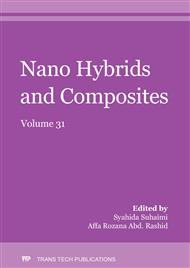p.1
p.7
p.17
p.25
p.35
p.45
p.55
p.65
p.73
Effect of Temperature on the Properties of Poly(Vinylpyrrolidone)-Iron Magnetic Nanocomposite for Oil Recovery
Abstract:
The poly (vinylpyrrolidone)-iron magnetic nanocomposite (PVP-Fe NCs) recently used for oil recovery since it capable to remove up to 80% of oil. However, the magnetic properties PVP-Fe NCs might not be consistently performed as it has a tendency to having low magnetism depending on their temperature. This study aims to investigate the effect of temperature of PVP-Fe NCs, to see the effectiveness of oil recovery from aqueous environment by using magnetic decantation method. The PVP-iron magnetic was synthesized by three steps using poly (vinylpyrrolidone), FeCl2•4H2O, FeCl3•6H2O and ammonia solution involving mixing and heating, precipitating and separating. The oil removal was tested by mixing the PVP-Fe NCs into an oil-water mixture to let it coat by oil. The oil-water separation was conducted by using a neodymium magnet. The experiments were repeated using the same PVP-materials with different temperatures such as room temperature, 50°C, 80°C and 90°C. The presence of OH-1 group and the magnetic property of each samples was characterized by using FTIR and VSM. The study reveals that the PVP-Fe NCs have highest magnetism at 80°C compared to other temperatures. 80°C seem to be the optimum temperature to perform the good magnetism of PVP-Fe NCs since it reduces its magnetism at 90°C due to its thicker coat. The also showed that PVP-Fe3 are hydrophilic that can assist in oil separation from water. This study demonstrated a significant finding in oil recovery application using PVP-iron magnetic nanocomposites materials.
Info:
Periodical:
Pages:
73-80
Citation:
Online since:
February 2021
Price:
Сopyright:
© 2021 Trans Tech Publications Ltd. All Rights Reserved
Share:
Citation:


